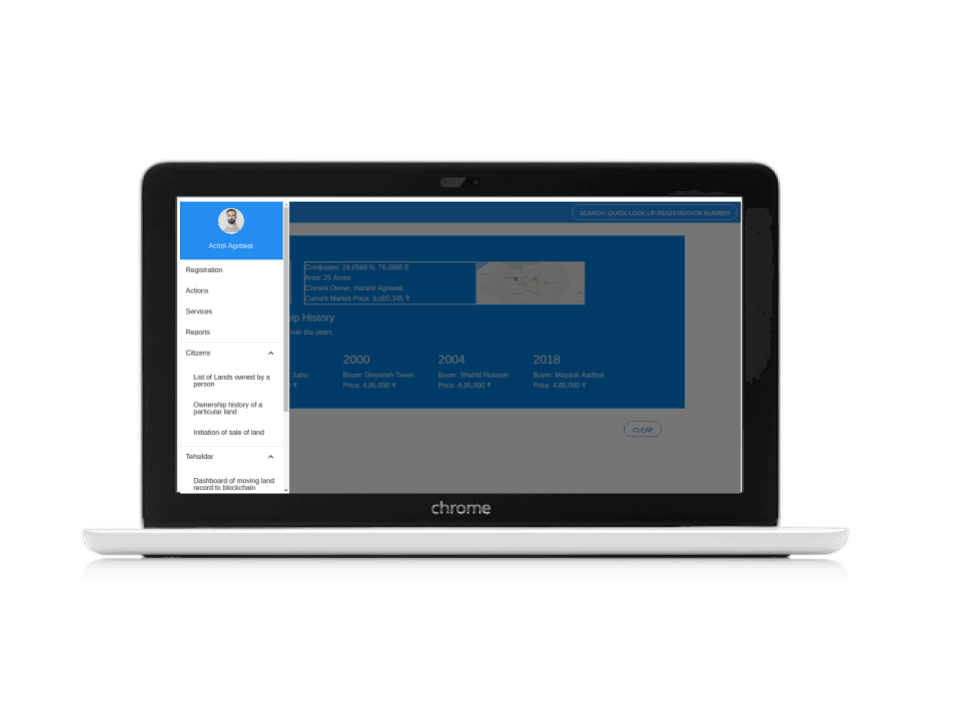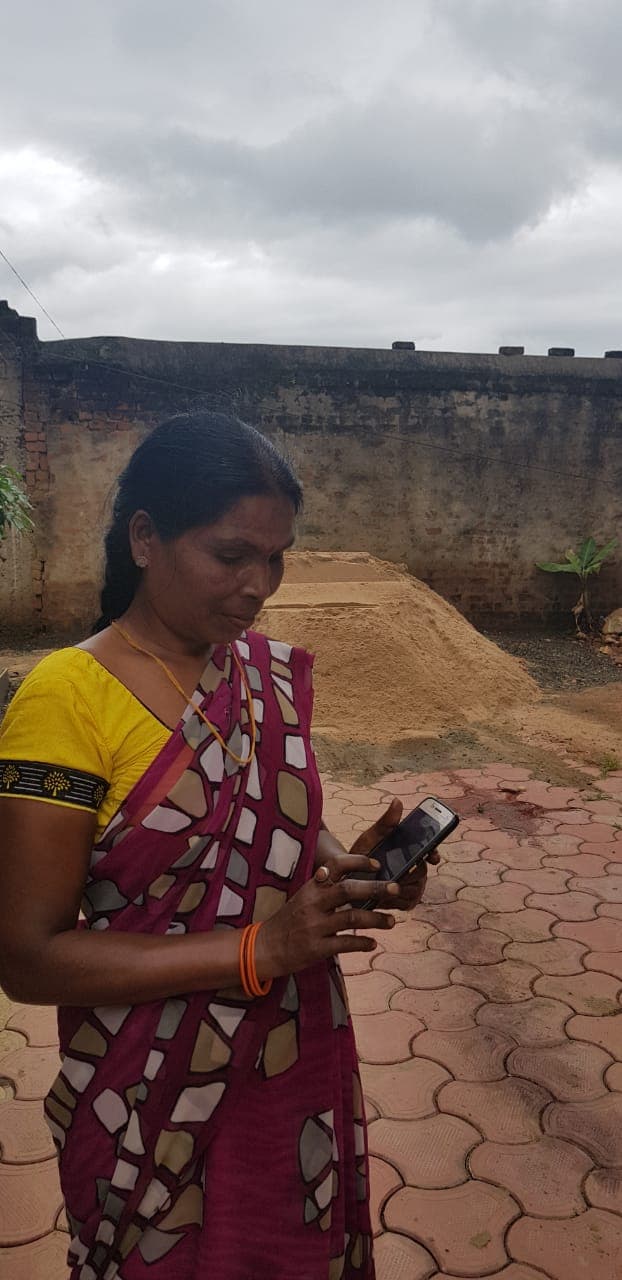LandChain
- Case Study Details
Description
Bringing transparency to land records for Chhattisgarh Government using blockchain technology to reduce corruption.
Tech Stack
BlockchainReactNode.jsSmart ContractsMobile App Development
The Problem: Opacity in Land Records
In 2019, I witnessed firsthand the frustration of a farmer trying to get a simple land ownership certificate in Chhattisgarh. What should have been a straightforward process became a month-long ordeal involving multiple government offices, unofficial "facilitators," and significant expense.
The systemic issues were glaring:
- Information asymmetry: Citizens had no direct access to their own land records
- Intermediary dependency: Farmers relied on village officials or agents who charged unofficial fees
- Process opacity: No visibility into application status or approval timelines
- Corruption vulnerability: Manual processes created opportunities for data manipulation
- Record fragmentation: Land records were scattered across multiple departments with no central verification
The human cost was enormous. Farmers couldn't access credit because they couldn't prove land ownership. Property disputes dragged on for years because records could be altered. The very foundation of agricultural finance—land as collateral—was undermined by systemic opacity.
Blockchain as a Tool for Transparency
Why Blockchain for Land Records?
When the Chhattisgarh government approached us, blockchain was still largely associated with cryptocurrency speculation. But for land records, blockchain's core properties were perfectly aligned with the problem:
- Immutability: Once recorded, land transactions couldn't be altered retroactively
- Transparency: All transactions would be visible to authorized parties
- Decentralization: No single point of failure or control
- Cryptographic verification: Mathematical proof of record authenticity
The key insight was that blockchain could serve as a trust layer in a low-trust environment.
Technical Architecture
I designed LandChain around a hybrid blockchain model that balanced transparency with privacy:
┌─────────────────────────────────────┐
│ Public Interface │ ← Citizen portal, mobile app
├─────────────────────────────────────┤
│ Government Dashboard │ ← Admin controls, verification
├─────────────────────────────────────┤
│ Blockchain Network │ ← Permissioned blockchain
├─────────────────────────────────────┤
│ Traditional Database │ ← Legacy system integration
└─────────────────────────────────────┘
Implementation Deep Dive
Smart Contract Design
The core of LandChain was a set of smart contracts that encoded land record business logic. The contracts managed land records with survey numbers, ownership details, boundaries, and registration dates, while maintaining complete audit trails through blockchain events.

The smart contracts handled land registration and transfers with proper authorization controls, ensuring that only authorized parties could update records while maintaining transparency for all stakeholders.
Citizen-Facing Interface Design
The biggest challenge wasn't technical—it was making blockchain accessible to farmers who might be using smartphones for the first time.
I designed the interface around three core user journeys:
1. Land Status Check
- Simple search by survey number or owner name
- Visual map integration showing land boundaries
- Clear ownership history with timeline view
2. Application Tracking
- QR code-based application IDs
- SMS notifications for status updates
- Progress indicators in local language
3. Document Verification
- Photo-based document upload
- Automatic OCR for data extraction
- Blockchain verification of document authenticity

Mobile-First Design Philosophy
Recognizing that mobile phones were often the primary computing device for rural citizens, I built the system mobile-first:
// Mobile-optimized land search component
const LandSearchMobile = () => {
const [searchMethod, setSearchMethod] = useState('survey'); // 'survey' or 'voice'
const [isLoading, setIsLoading] = useState(false);
const handleVoiceSearch = async () => {
try {
const recognition = new (window.SpeechRecognition || window.webkitSpeechRecognition)();
recognition.lang = 'hi-IN'; // Hindi language support
recognition.continuous = false;
recognition.onresult = async (event) => {
const spokenText = event.results[0][0].transcript;
const extractedSurveyNumber = extractSurveyNumber(spokenText);
if (extractedSurveyNumber) {
await searchLandRecord(extractedSurveyNumber);
}
};
recognition.start();
} catch (error) {
// Fallback to text input
setSearchMethod('survey');
}
};
return (
<div className="mobile-search-container">
<div className="search-methods">
<button
onClick={() => setSearchMethod('survey')}
className={searchMethod === 'survey' ? 'active' : ''}
>
सर्वे नंबर लिखें
</button>
<button
onClick={handleVoiceSearch}
className={searchMethod === 'voice' ? 'active' : ''}
>
बोलकर खोजें
</button>
</div>
{/* Search interface components */}
</div>
);
};
Overcoming Adoption Challenges
Government Stakeholder Education
One of the biggest hurdles was explaining blockchain benefits to government officials who were understandably skeptical of new technology. I developed a series of demonstrations that showed concrete benefits:
Before Blockchain: Traditional paper-based demo with multiple people trying to verify and cross-reference documents—showing how easy it was to introduce errors or manipulation.
After Blockchain: Digital demo where any changes were immediately visible and verifiable by all parties, with complete audit trails.
The "aha moment" usually came when officials realized they could verify land records instantly without calling other departments.
Building Trust with Citizens
Citizens were initially skeptical about putting their land records "on the internet." I addressed this through:
1. Community Demonstrations
- Village-level meetings explaining the system
- Showing how blockchain made records MORE secure, not less
- Demonstrating that citizens would have MORE control, not less
2. Gradual Rollout
- Started with new registrations rather than migrating existing records
- Allowed side-by-side operation with traditional systems
- Gave citizens choice about participation
3. Transparency About Technology
- Published simple explanations of how blockchain works
- Provided verifiable examples of record integrity
- Showed citizens how to verify their own records
Technical Infrastructure Challenges
Deploying blockchain in rural India required solving several infrastructure problems:
Network Connectivity: Built offline-first capabilities that could sync when connectivity was available.
Device Compatibility: Ensured the system worked on basic Android phones with limited RAM and storage.
Power Reliability: Designed for intermittent power supply with automatic data backup and recovery.
Results and Impact
Quantitative Outcomes
After 12 months of operation:
- 70% reduction in land registration time (from 3-4 weeks to 3-5 days)
- 95% elimination of intermediary dependencies for basic land queries
- Zero tampering incidents: No successful attempts to alter historical records
- 60% cost reduction for citizens (elimination of unofficial fees)
- 40,000+ land records successfully migrated to blockchain
Qualitative Impact Stories
Ramesh, Farmer from Durg District: "Earlier, I had to take 3 days off work and travel to the tehsil office just to get a land certificate. Now I can check my land details on my phone and get certificates the same day."
Priya, Village Revenue Officer: "The system has eliminated so many disputes. When someone claims their boundary was changed, we can show them the complete history. There's no argument against mathematics."
Suresh, Bank Manager: "We can now verify land collateral in minutes instead of weeks. This has allowed us to extend credit to farmers who previously couldn't prove their land ownership."
Systemic Changes
The blockchain implementation triggered broader administrative improvements:
- Digitization of related processes: Other departments began adopting digital workflows
- Reduced corruption opportunities: Transparent processes made unofficial payments unnecessary
- Improved data quality: Blockchain requirements forced cleanup of legacy data inconsistencies
- Enhanced citizen confidence: People began trusting government digital services more broadly
Technical Lessons Learned
Blockchain is Infrastructure, Not Interface
The most important realization was that citizens don't need to understand blockchain—they need to see its benefits. The technical sophistication should be invisible to end users.
// Good: Simple interface hiding complex backend
function getLandStatus(surveyNumber) {
return {
owner: "राम कुमार शर्मा",
area: "2.5 एकड़",
status: "पंजीकृत",
lastUpdated: "15 मार्च 2019",
verificationCode: "BLK-2019-DRG-1234"
};
}
// Bad: Exposing blockchain complexity
function getLandStatusFromBlockchain(surveyNumber) {
return {
blockHash: "0x1234567890abcdef...",
transactionId: "0xabcdef1234567890...",
merkleProof: [...],
rawLandData: {...}
};
}
Permissioned Networks for Government Use Cases
Public blockchains were inappropriate for government data that required privacy controls. Our permissioned network allowed:
- Role-based access: Different permissions for citizens, officials, and auditors
- Privacy compliance: Sensitive data could be encrypted or kept off-chain
- Regulatory compliance: Met government requirements for data sovereignty
- Performance optimization: Higher transaction throughput than public networks
Legacy Integration is Critical
No government system exists in isolation. LandChain had to integrate with:
- Existing land records databases: Gradual migration rather than complete replacement
- Revenue collection systems: Tax calculations based on updated land records
- Court systems: Providing verifiable records for legal proceedings
- Banking systems: Enabling faster collateral verification
The Broader Implications for GovTech
Technology as a Trust Builder
LandChain demonstrated that technology can rebuild trust between citizens and government. When processes are transparent and verifiable, cynicism gives way to confidence.
The ripple effects extended beyond land records:
- Citizens became more willing to engage with other digital government services
- Officials gained confidence in digital processes for other departments
- The success created a template for digitizing other government functions
The Importance of Change Management
Technical implementation was only 30% of the project. The remaining 70% was change management:
- Training programs for government staff
- Community education about the new system
- Process redesign to accommodate digital workflows
- Policy updates to reflect new technological capabilities
Measuring Success Beyond Efficiency
While efficiency gains were important, the real success metrics were about human dignity:
- Reduced humiliation: Citizens no longer had to plead with officials for basic services
- Increased agency: People could verify their own records and track their applications
- Enhanced economic opportunity: Faster land verification enabled quicker access to credit
- Restored faith: Trust in government processes began to recover
What This Taught Me About Conscious Technology
LandChain was my first experience building technology for social impact at scale. It taught me several principles that now guide all my work:
1. Technology Must Serve the Least Privileged First
If a system works for a barely-literate farmer with a basic smartphone, it will work for everyone. Designing for constraints produces better solutions for all users.
2. Transparency is a Prerequisite for Trust
In low-trust environments, technological sophistication is less important than transparency. People need to understand and verify how systems work, even if they don't understand the underlying technology.
3. Human-Centered Design Beats Technical Optimization
The most elegant smart contract is worthless if real people can't use it effectively. User experience research and iterative design were more valuable than blockchain optimization.
4. Systemic Change Requires Patience
Deploying technology in government requires understanding political, social, and bureaucratic contexts. Technical solutions must align with human incentives to create lasting change.
The Future of Governance Technology
LandChain was a proof of concept for a larger vision: governance systems that are transparent by design rather than transparent by accident.
Imagine a world where:
- Every government decision has a clear, verifiable audit trail
- Citizens can track the progress of their applications in real-time
- Public resources are allocated through transparent, algorithmic processes
- Corruption becomes mathematically impossible rather than just legally prohibited
This vision requires more than just good technology—it requires a fundamental shift in how we think about the relationship between citizens and their governments. Technology can enable this shift, but only if it's designed with deep empathy for human needs and constraints.
The lessons from LandChain continue to influence every government technology project I work on. The goal isn't just to digitize existing processes—it's to use technology to create new possibilities for human flourishing within governance systems.
